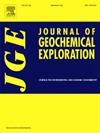Late mesozoic exhumation of silurian – Devonian and permian Ni-Co sulfide deposits in the East Kunlun orogenic belt: Constraints from zircon fission track ages
IF 3.4
2区 地球科学
Q1 GEOCHEMISTRY & GEOPHYSICS
引用次数: 0
Abstract
Ni-Co sulfide deposits of late Silurian – early Devonian and Permian ages hosted within in basic-ultrabasic rock bodies in the East Kunlun orogenic belt have been extensively investigated. Nevertheless, we have only a limited understanding of the history and dynamics of uplift, exhumation, and tectonic deformation of the basic-ultrabasic ore-bearing rock bodies of these Ni-Co sulfide deposits. We used the zircon fission track ages of seven samples obtained from basic-ultrabasic ore-bearing rocks to determine the timing of the exhumation of these Ni-Co sulfide deposits. Combining our results with published data on the timing of orogenesis, cooling events, magmatic activities, and basin infilling in adjacent areas, we conclude the following: 1) The ZFT ages obtained in this study indicate the exhumation during 169.6 ± 5.5–142.2 ± 3.2 Ma; 2) Combined with previous results, our data indicate that the exhumation during the Jurassic – Cretaceous occurred across a large area along the East Kunlun orogenic belt to the Alxa block; 3) The synchroneity of orogeny, magmatic activity, and basin infilling events suggests that the late Mesozoic exhumation was a geomorphological response to the Lhasa-Qiangtang collision driven by the breakup of Gondwanaland.
东昆仑造山带志留纪-泥盆纪和永生纪镍钴硫化物矿床的中生代晚期掘起:锆石裂变轨迹年龄的制约因素
对东昆仑造山带基性-超基性岩体中赋存的志留纪晚期-泥盆纪早期和二叠纪硫化镍钴矿床进行了广泛的研究。然而,我们对这些镍钴硫化物矿床的基性-超基性含矿岩体的隆起、掘起和构造变形的历史和动态了解有限。我们利用从基性-超基性含矿岩体中获得的七个样本的锆石裂变轨迹年龄来确定这些硫化镍钴矿床的隆升时间。将我们的研究结果与已发表的有关邻近地区造山运动、冷却事件、岩浆活动和盆地充填时间的数据相结合,我们得出以下结论:1) 本研究获得的 ZFT 年龄表明,成岩时间为 169.6 ± 5.5-142.2 ± 3.5 Ma;2) 结合已公布的岩浆活动和盆地充填时间,我们得出以下结论2Ma;2)结合之前的研究结果,我们的数据表明,侏罗纪-白垩纪的掘起发生在沿东昆仑造山带至阿拉善地块的大片区域;3)造山、岩浆活动和盆地充填事件的同步性表明,中生代晚期的掘起是冈瓦纳兰断裂驱动拉萨-羌塘碰撞的地貌反应。
本文章由计算机程序翻译,如有差异,请以英文原文为准。
求助全文
约1分钟内获得全文
求助全文
来源期刊

Journal of Geochemical Exploration
地学-地球化学与地球物理
CiteScore
7.40
自引率
7.70%
发文量
148
审稿时长
8.1 months
期刊介绍:
Journal of Geochemical Exploration is mostly dedicated to publication of original studies in exploration and environmental geochemistry and related topics.
Contributions considered of prevalent interest for the journal include researches based on the application of innovative methods to:
define the genesis and the evolution of mineral deposits including transfer of elements in large-scale mineralized areas.
analyze complex systems at the boundaries between bio-geochemistry, metal transport and mineral accumulation.
evaluate effects of historical mining activities on the surface environment.
trace pollutant sources and define their fate and transport models in the near-surface and surface environments involving solid, fluid and aerial matrices.
assess and quantify natural and technogenic radioactivity in the environment.
determine geochemical anomalies and set baseline reference values using compositional data analysis, multivariate statistics and geo-spatial analysis.
assess the impacts of anthropogenic contamination on ecosystems and human health at local and regional scale to prioritize and classify risks through deterministic and stochastic approaches.
Papers dedicated to the presentation of newly developed methods in analytical geochemistry to be applied in the field or in laboratory are also within the topics of interest for the journal.
 求助内容:
求助内容: 应助结果提醒方式:
应助结果提醒方式:


